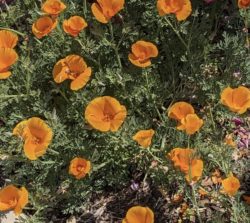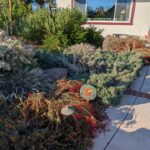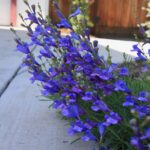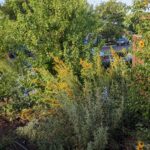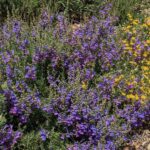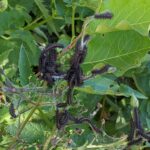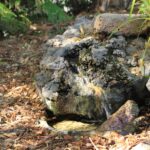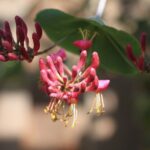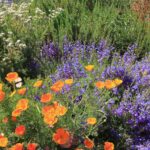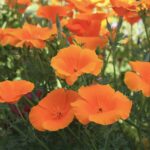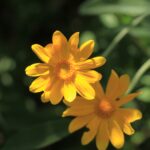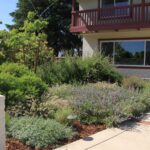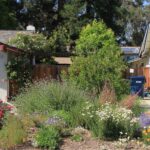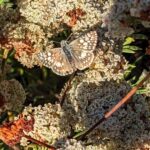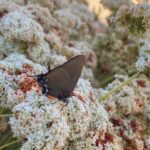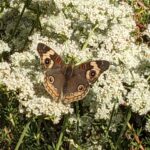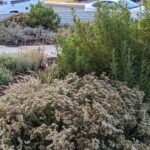Lot size: 2100 sq. ft. front, and 3,100 sq. ft. back garden, 80% native
Garden Age: Garden was installed in stages, beginning in 2021
Years on the Bringing Back the Natives Garden Tour: 2
Showcase Feature
Doug Tallamy’s talk on the Bringing Back the Natives Garden Tour’s first virtual garden tour, in 2020, motivated Carol and Jeff to remove their recently installed “drought-tolerant” landscaping and replace it with California natives, in order to create a “caterpillar garden.” Many people don’t know that baby birds must have caterpillars—thousands of them!—while the chicks are in their nests, and even after they fledge. Baby birds do not eat berries, or seeds, or sugar water; they must have caterpillars.
Carol and Jeff’s goal is to increase food sources for chicks and adult birds, to try to reverse the very rapid decline in numbers and species of birds and butterflies they have seen in their yard. In addition to creating a garden for wildlife, Carol wanted a lush-looking landscape, and is very happy with the plant choices that designer Kelly Marshall, of Kelly Marshall Garden Design, made for the front garden. The shady back yard, dominated by a large coast live oak and other mature trees, was designed with a preliminary list of shade-loving plants suggested by Kelly: Carol and Jeff took it from there, and they installed the back garden themselves.
Other Garden Attractions
•Stop by Zone 7’s table and chat with their friendly representative about Zone 7’s lawn-removal rebates—you can now get $1.00 a sq. ft for removing either your front or back lawn, up to $2,000 total. On the day of the Tour snacks, drinks, and a game for children will be available.
•Enjoy the variety of textures, colors and scents in this garden! Jeff and Carol enjoy sitting in the sunken patio or at the backyard dining table to watch the birds at the feeders, or just listen to the water and commune with the trees. They hope you will, as well! Take a seat and enjoy this lovely garden; you won’t want to leave.
 Gardening for Wildlife
Gardening for Wildlife
More than fifty species of birds have been seen in the garden. White and golden-crowned sparrows, cedar waxwings, Nuttall’s and Downy woodpeckers, northern flickers, bushtits, chestnut backed chickadees, both red and white-breasted nuthatches, oak titmice, robins, great horned and barn owls, and more all visit the feeders, fountain, and bird baths; they also forage in the trees and bushes.
The native plants also attract butterflies—buckeye, common checkered skipper, West Coast ladies and the great purple hairstreak were not seen in the garden when it was planted with non-native ornamentals—and it took a few years to attract them to the new, native plant garden. In addition to the butterflies listed above, hairstreaks, metalmarks and skippers spend time in the garden, as do many beautiful moths. Occasionally, a tiger swallowtail floats through. Leaves are left on the ground, as the pupa of butterflies and moths spend the winter attached to dried leaves, or nestled under leaf litter. Compost the leaves, and you are throwing away butterflies.
Baby lizards appeared in the garden last spring, along with lots of ladybugs and praying mantis, and many kinds and sizes of bees and wasps.
In order to enjoy their garden more, Jeff and Carol bought some close-focus binoculars so they could try to identify the many kinds of bees and butterflies that began showing up recently, when the plants were really established.
 Carol notes, “The first day we started the fountain in the backyard, years ago, a flock of black headed grosbeaks showed up! We were delighted. We used to have huge flocks of cedar waxwings and robins coming to the fountain to drink and bathe—but we have seen the alarming decline in bird populations in our own garden. Sadly, the number of birds in our garden has dropped drastically over the past five years or so. We hope that providing plenty of native food sources for caterpillars and other insects will help reverse that loss.”
Carol notes, “The first day we started the fountain in the backyard, years ago, a flock of black headed grosbeaks showed up! We were delighted. We used to have huge flocks of cedar waxwings and robins coming to the fountain to drink and bathe—but we have seen the alarming decline in bird populations in our own garden. Sadly, the number of birds in our garden has dropped drastically over the past five years or so. We hope that providing plenty of native food sources for caterpillars and other insects will help reverse that loss.”
Garden Talks
11:00 and 2:00 “Chances are, you have never thought of your garden as a wildlife preserve that represents the last opportunity we have for sustaining plants and animals: join me to hear how you can help!” by Carol Garberson
Keystone species (watch this talk by Doug Tallamy!)
Keystone species—our own, local ecological powerhouse plants— in this garden include coast live oak, Catalina cherry, aster, golden and red-flowering currant, California lilac, sunflower, manzanita, lupine, woodland strawberry, goldenrod, buckwheat, sages, and penstemon.
Green Home Features
Solar panels reduce the family’s PG&E bill. A whole house fan, which cuts the need for air conditioner use dramatically.
Front garden annotated plant list
At least partially wheelchair accessible? Yes


